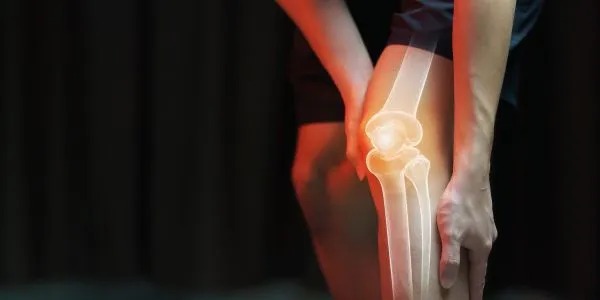Understanding Total Knee Replacement Surgery
Total knee replacement surgery, also known as total Knee arthroplasty involves removing the Removing the damaged cartilage and bone from The knee joint and replacing it with artificial components made from metal alloys, high-quality plastics, and durable polymer. This procedure is generally advised for patients experiencing severe symptoms Knee pain and limited mobility resulting from Conditions like osteoarthritis, rheumatoid arthritis, or other degenerative joint disorders post-traumatic arthritis that haven’t responded to conservative treatments like medication, physical therapy, or lifestyle modifications.

The procedure has evolved significantly over the years, with modern techniques offering improved outcomes and faster recovery times. Dr. Anil K Jain employs the latest surgical approaches to ensure optimal results for patients in the Vaishali, Ghaziabad region.
Most patients wonder about knee replacement surgery recovery time when considering this procedure. While individual experiences vary, understanding the typical A clear timeline can help establish realistic expectations and aid in preparing for the recovery process and the recovery journey ahead.
Before Surgery: The Preparation Phase
Initial Consultation and Evaluation
The process starts with a detailed consultation at AVEE HOSPITAL, where Dr. Anil K Jain will evaluate your knee condition, medical history, and overall health. This assessment typically includes:
- Physical examination of the knee
- Review of previous treatments and their effectiveness
- X-rays and possibly MRI scans to assess joint damage
- Blood tests to detect infection or other potential issues.
- Discussion about your pain levels and mobility limitations
During this consultation, You’ll have the chance to discuss the procedure, recovery timeline, and any other concerns you may have expected outcomes. It’s important to discuss your goals and expectations to ensure they align with what the surgery can realistically achieve.
Medical Preparation
Proper preparation can help minimize knee replacement surgery risks and improve outcomes. In the weeks leading up to surgery, you may need to:
- Adjust medications, particularly blood thinners
- Complete pre-operative testing
- Address any dental issues, as infections can affect the new joint
- Stop smoking, as it can impede healing and increase infection risk
- Limit alcohol consumption to reduce bleeding and dehydration risks
Your surgeon will provide personalized instructions based on your specific condition and needs and individual health needs. Following these guidelines carefully is crucial for a successful outcome.
Home Preparation
Preparing your home environment before surgery can make your recovery period much more comfortable and safer. Consider these modifications:
- Install handrails in bathrooms and stairways
- Remove trip hazards like loose rugs and cords
- Arrange for a toilet seat lift and shower chair
- Set up a recovery area on the main floor to avoid stairs
- Place frequently used items within easy reach
- Arrange for assistance with daily activities for the first few weeks
Many patients find it helpful to prepare meals in advance and stock up on essentials to minimize the need for shopping during early recovery.
Types of Knee Replacement Procedures
Multiple types of knee replacement procedures are available to suit different needs and conditions, including total and partial replacements. Understanding the different types of knee replacement can help patients have informed discussions with their surgeons.
Total Knee Replacement
Total knee replacement surgery involves replacing all three compartments of the knee: the medial (inner), lateral (outer), and patellofemoral (kneecap) compartments. This is the most common type and is typically recommended for patients with widespread arthritis affecting multiple areas of the knee joint.
The procedure involves:
- Removing damaged cartilage and bone
- Reshaping the bone ends to accommodate the implants
- Placing metal components on the femur (thigh bone) and tibia (shin bone)
- Inserting a plastic spacer between these components to allow smooth movement
- Possibly resurfacing the underside of the kneecap with a plastic button
Partial Knee Replacement
When arthritis impacts just one compartment of the knee, a partial (unicompartmental) knee replacement may be an option. This procedure targets only the damaged portion of the knee, preserving healthy bone and tissue. Benefits include:
- Smaller incision
- Less blood loss
- Quicker recovery
- More natural feeling knee
- Preservation of healthy tissue
Other Specialized Procedures
Other variations include:
- Patellofemoral replacement (focusing on the kneecap area)
- Bilateral knee replacement (replacing both knees simultaneously)
- Revision knee replacement (replacing or repairing a previous implant)
Dr. Anil K Jain will determine which of the types of knee replacement is most suitable for your specific condition based on factors like age, activity level, anatomy, and the extent of arthritis.
The Surgery Process
Before the Procedure
On the day of surgery at AVEE HOSPITAL, you’ll go through several preparatory steps:
- Check-in and administrative procedures
- Final pre-operative assessment
- Meeting with the anesthesiologist to discuss options
- Marking of the surgical site
- Administration of antibiotics to prevent infection
During the Procedure
Total knee replacement surgery typically takes 1-2 hours. The procedure follows these general steps:
- Administration of anesthesia (either general or spinal)
- Cleaning and sterilization of the surgical area
- Creation of an incision at the front of the knee
- Careful removal of damaged cartilage and bone
- Preparation of the bone surfaces for the implants
- Placement and testing of trial components
- Cementing of the final implants into place
- Closure of the incision with stitches or staples
- Application of sterile dressings
What happens during total knee replacement surgery may vary slightly based on individual patient needs and the specific surgical approach used.
Immediate Post-Surgery Period
Hospital Stay
After surgery, you’ll be moved. You will be transferred to a recovery room, where medical staff will closely monitor your condition and monitor your vital signs. Once stable, you’ll be transferred to a hospital room. The average hospital stay following knee replacement is 1-3 days, during which:
- Your pain will be managed with appropriate medications
- You’ll begin working with physical therapists
- Medical staff will monitor for potential complications
- You’ll learn how to safely move and care for your new knee
Pain Management
Effective pain management is a key element of the recovery process and the recovery process. Your medical team at AVEE HOSPITAL will develop a pain management plan that may include:
- IV pain medications initially
- Oral pain relievers
- Nerve blocks in some cases
- Cold therapy to reduce swelling
- Proper positioning of the leg
Effective pain management allows for earlier mobilization, which is crucial for successful recovery.
Initial Mobility
Surprisingly to many patients, you’ll be encouraged to start moving your new knee and walking (with assistance) within 24 hours of surgery. This early mobilization helps prevent complications like blood clots and promotes healing. During your hospital stay, you’ll:
- Learn how to use assistive devices such as walkers or crutches effectively crutches
- Practice getting in and out of bed safely
- Begin basic knee replacement exercises under supervision
- Learn proper wound care techniques
Recovery Timeline and Expectations
The typical knee replacement surgery recovery time involves several phases spanning from immediate post-operative care to complete rehabilitation. Factors that can affect knee replacement surgery recovery time include age, overall health, and commitment to physical therapy.
Weeks 1-2: Early Recovery
After discharge from AVEE HOSPITAL, you’ll focus on:
- Managing pain and swelling
- Performing prescribed exercises
- Keeping the incision clean and dry
- Using assistive devices for walking
- Attending follow-up appointments
- Preventing complications through movement and medication
During this phase, you’ll likely need assistance with daily activities and transportation.
Weeks 3-6: Progressive Recovery
As healing progresses, you’ll experience:
- Decreasing pain and swelling
- Improved range of motion
- Transition from walker to cane
- Increased independence in daily activities
- More advanced physical therapy exercises
- Possibly beginning to drive (typically after 4-6 weeks)
Months 2-3: Advanced Recovery
During this period, most patients see significant improvements:
- Walking without assistive devices
- Returning to light activities and possibly work
- Continuing with strengthening exercises
- Experiencing less pain with activity
- Improved stamina and endurance
Months 4-12: Long-term Recovery
Complete recovery can take up to a year, during which you’ll continue to gain strength and function:
- Resuming most normal activities
- Possibly returning to low-impact sports
- Experiencing continued improvement in strength
- Adapting to the feel of your new knee
- Having less frequent physical therapy sessions
Physical Therapy and Rehabilitation
Proper knee replacement exercises are crucial for restoring mobility and strength after surgery. Your physical therapist will recommend specific knee replacement exercises tailored to your recovery stage.
Essential Exercises
Common knee replacement exercises include:
- Ankle pumps: Gently moving your foot up and down to improve circulation and prevent blood clots.
- Quadriceps Sets: Tightening the thigh muscle while keeping the leg straight to strengthen the muscles that support the knee.
- Straight Leg Raises: Lifting the leg straight up while keeping the knee locked to build strength.
- Knee Bends: Gently bending the knee while seated or lying down to improve flexibility.
- Walking: Gradually increasing distance with appropriate assistive devices.
- Stair Climbing: Practicing safe techniques for navigating steps.
As recovery progresses, more challenging exercises will be added to build strength, improve balance, and enhance functional mobility.
Rehabilitation Progression
Rehabilitation typically follows this progression:
- Basic Movement: Focusing on range of motion and circulation
- Functional Training: Learning to perform daily activities safely
- Strength Building: Developing muscle support around the knee
- Endurance Training: Building stamina for longer activities
- Balance and Coordination: Improving stability and preventing falls
- Activity-Specific Training: Preparing for return to specific hobbies or sports
Consistent participation in physical therapy and home exercises is one of the most important factors in determining the success of your knee replacement.
Success Rates and Long-term Outcomes
The knee replacement success rate exceeds 85% for symptomatic improvement according to recent studies. At AVEE HOSPITAL, the knee replacement success rate is comparable to national standards due to advanced surgical techniques.
Factors Affecting Success
Factors that can influence the knee replacement success rate include:
- Patient age and overall health
- Severity of knee damage before surgery
- Adherence to rehabilitation protocols
- Surgeon experience and technique
- Implant quality and design
- Weight management after surgery
- Activity level and lifestyle choices
Long-term Expectations
Modern knee replacements are designed to last 15-20 years or longer. Studies show that about 90-95% of knee replacements are still functioning well 10 years after surgery, and about 80-85% at 20 years.
Most patients can expect:
- Significant or complete pain relief
- Improved ability to walk, climb stairs, and perform daily activities
- Correction of knee deformities like bowlegs or knock knees
- Enhanced quality of life and independence
While knee replacements are highly successful, they may not allow for high-impact activities like running or jumping. However, low-impact activities like walking, swimming, cycling, and golf are typically encouraged after full recovery.
Potential Complications and How to Minimize Risks
While generally safe, knee replacement surgery risks include infection, blood clots, and implant issues. Understanding these risks and implementing preventive measures is crucial for ensuring safety and promoting recovery with a successful outcome.
Common Complications
Potential complications include:
- Blood Clots: These can form in the leg veins and potentially travel to the lungs.
- Prevention: Early mobilization, blood-thinning medications, compression stockings
- Infection: It can develop at the incision site or in the surrounding area deep around the prosthesis.
- Prevention: Antibiotics, proper wound care, good hygiene
- Implant Problems: Including loosening, wear, or alignment issues.
- Prevention: Proper surgical technique, following activity guidelines
- Stiffness: Difficulty bending or straightening the knee.
- Prevention: Consistent physical therapy, following exercise protocols
- Persistent Pain: Some patients may experience ongoing discomfort.
- Management: Physical therapy, medication, identifying and addressing the cause
Warning Signs
Contact AVEE HOSPITAL immediately if you experience:
- Fever over 100.4°F (38°C)
- Increasing pain, redness, or swelling in the knee
- Drainage from the incision
- Calf pain or swelling
- Chest pain or shortness of breath
- Opening of the wound
Conclusion: Your Path to Renewed Mobility
Total knee replacement surgery can be transformative for individuals experiencing severe knee pain and difficulty with mobility, especially those suffering from debilitating knee conditions. By understanding what to expect before, during, and after the procedure, you can approach your surgery with confidence and realistic expectations. For comprehensive care, consider consulting a multispeciality hospital in Ghaziabad that offers advanced orthopedic services and expert post-surgical support.
The journey requires commitment, particularly to the rehabilitation process, but the rewards of reduced pain and improved function make the effort worthwhile for most patients. With the expert care provided by Dr. Anil K Jain, residents of Ghaziabad and surrounding areas have access to high-quality orthopedic care close to home.
If knee pain is limiting your activities and affecting your quality of life, consider scheduling a consultation to learn whether knee replacement might be right for you. The path to renewed mobility and a more active lifestyle may be closer than you think.
For more information or to schedule an appointment, contact AVEE HOSPITAL VAISHALI SECTOR 6 today. Take the first step toward a life with less pain and more mobility.

